The Benefits of Deaccessioning Unused Items in Museums: A Smart Strategy for Financial Sustainability
In the world of museums, the careful management of collections is essential for maintaining their cultural and educational missions. However, as collections grow over time, there are often items that become outdated, irrelevant, or simply take up valuable storage space. Deaccessioning—removing an item from the museum’s permanent collection—is a vital process that many museums are increasingly considering. This practice, while controversial at times, offers numerous benefits to museums, especially in the context of raising funds, reducing expenditures, and sustaining long-term operations.
- Raising Funds to Further the Museum’s Mission
One of the most immediate and powerful benefits of deaccessioning is the potential to raise funds that can be reinvested into the museum’s mission. Selling unused or unnecessary objects can generate significant revenue that allows museums to fund educational programs, preserve and care for their remaining collections, purchase relevant items for exhibition, or invest in much-needed renovations and expansions.
Museums that are struggling with financial constraints can often turn to deaccessioning as a way to bolster their financial health. Funds from selling items can support essential operational costs, such as staff salaries, acquisitions of new works, and special exhibits that attract visitors and raise awareness of the museum’s value to the community.
- Decreased Expenditures on Storage
Museums face significant costs related to the storage and maintenance of their collections. As collections expand, the need for storage space grows, sometimes requiring costly off-site warehouses, climate control systems, and specialized storage materials. These expenses can quickly add up, diverting resources away from more pressing priorities.
By deaccessioning unused or irrelevant items, museums can downsize their storage requirements and, in turn, reduce expenditures. Fewer items mean fewer resources spent on preserving, storing, and managing objects that no longer serve the museum’s mission. It also creates a more organized and manageable collection that can be more effectively cared for, with limited staff and financial resources.
- Addressing the Rising Costs of Maintaining a Museum
The rising costs of running a museum—due to inflation, increasing insurance premiums, and a general increase in operational expenses—pose challenges for many institutions. For smaller museums or those facing decreased attendance, deaccessioning offers a practical solution to offset these rising costs.
Museum maintenance, including cleaning, climate control, and security, becomes increasingly expensive as collections grow. By divesting of non-essential objects, museums can free up space and reduce the ongoing costs associated with maintaining these items, ultimately allowing them to focus resources on the more critical elements of their collection.
- Managing Decreased Attendance and Donations
Many museums are also grappling with decreased attendance, which translates into lower revenues from ticket sales, special programs, and merchandise. This decline in visitors can also affect the volume of new donations. As public interest wanes, some museums face an overabundance of donated items that may not fit with their collection strategy or mission.
Deaccessioning allows museums to streamline their collections and ensure that the items they hold remain relevant to their audience and objectives. It also gives museums the ability to recapture space that may be used for more engaging exhibits or visitor-focused areas, boosting the overall visitor experience. Reducing the clutter of donated items helps curators focus on the most important pieces, which can drive further engagement and public interest.
- The Power of Auctions for Quick and Efficient Sales
A popular and efficient way for museums to deaccession and sell unwanted items is through auctions. Auction houses are well-equipped to handle all aspects of the deaccessioning process, from advertising and marketing to photographing and listing items for sale. This method offers a quick turnaround and minimizes the administrative burden on museum staff, allowing them to focus on other important tasks.
Auctions also have the advantage of bringing in specialized audiences interested in specific types of objects, such as collectors or enthusiasts who are looking for unique pieces. Auctions handle the logistics of insuring items, photographing them, writing descriptions, and collecting payments, which would otherwise require significant time and effort from the museum’s staff.
Moreover, because auctions often attract competitive bids, museums can sell items for higher-than-expected prices. This can generate a greater revenue than other methods of selling, benefiting the museum’s financial standing and ensuring that the object is placed in the hands of someone who truly values it.
- Ethical and Transparent Deaccessioning Practices
While deaccessioning is a valuable tool for museums, it must be done with great care and consideration. Museums must adhere to ethical guidelines and be transparent about the process. For instance, the proceeds from deaccessioning should generally be used for purposes directly related to the museum’s mission, such as the acquisition of new objects, educational programs, or conservation efforts.
Additionally, museum staff and trustees must ensure that deaccessioning is not used solely as a financial strategy but as part of a well-considered plan to improve the overall collection and the museum’s sustainability. Clear policies and communication with stakeholders, including donors and patrons, are essential for maintaining trust and credibility in the community.
Conclusion
Deaccessioning offers museums a strategic way to generate funds, reduce storage costs, and manage the rising financial pressures they face. Selling unused or irrelevant items—through the efficient and streamlined process of auctions—can help museums maintain their operations and improve the visitor experience, ultimately allowing them to continue their valuable work in education, culture, and preservation. By embracing deaccessioning as a tool for financial sustainability, museums can ensure that their collections remain meaningful, focused, and aligned with their long-term goals, all while securing the resources necessary to thrive in an increasingly challenging environment.




